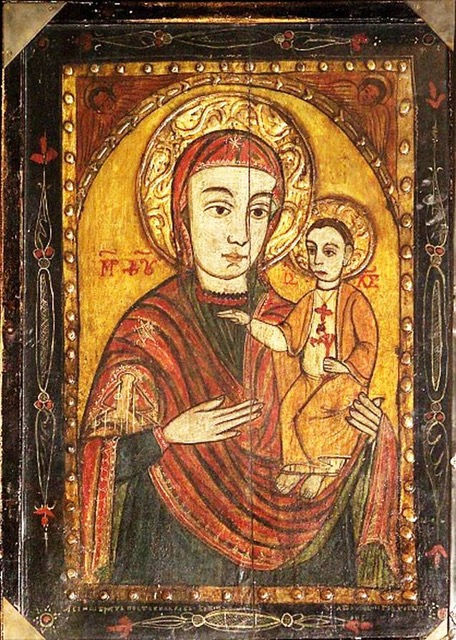In St. Stephen's Cathedral in Vienna, many people pray every day before a simply painted icon of the Virgin Mary with the Child Jesus. It is the miraculous image from the small town of Máriapócs in Hungary, which shed tears in 1696. The icon was then immediately transferred to the capital of the Habsburg Empire; but the extraordinary events in the small Hungarian town where the grace had occurred did not end there.
Hungary, late 17th century. Much of the country has just been liberated from Turkish rule, and large areas were still depopulated after 150 years of constant warfare. The country is now owned by the Austrian Habsburgs, but many of the nobles and much of the people are unhappy that the king of Hungary no longer resides in the royal castle of Buda (a part of present-day Budapest), but in distant Vienna.


In the small wooden church, of Greek-Catholic rite, in the village of Pócs - today located in the northeast of the country - there was then a simple icon of St. Mary painted by the brother of a priest. It belongs to the type of the "Hodegetria" ("she who shows the way") and shows Mary as she points with her finger to the child Jesus on her arm. One day, on November 4, 1696, a peasant who was present during the Sacred Liturgy noticed that tears were flowing from the icon's eyes. The phenomenon, which continued intermittently until December 8, was immediately investigated by the ecclesiastical and civil authorities. Hungary is very fragmented confessionally, but this circumstance is providential in relation to the examination of the miracle: not only Catholics, but also numerous Lutheran and Calvinist Christians attest to the authenticity of the event.
Emperor Leopold I and, above all, his wife Eleanor Magdalena also heard about the event. Soon the decision was made: the miraculous image had to be taken to the center of the empire, to the imperial seat in Vienna! On March 1, 1697, the icon was dismantled in Pocs against the will of the population and moved to Vienna, where it was venerated for months with numerous solemn masses and processions. It was finally given a permanent place in St. Stephen's Cathedral. The veneration of the miraculous image in the Empire grew even more when, only a few months later, on September 11, 1697, Prince Eugene of Savoy won the victory over the Ottomans at the battle of Zenta (then in Hungary, today in Serbia). The imperial family and the preachers of the time attributed the triumph to the intercession of Our Lady of Pötsch, as the Hungarian town is known in German.
The local inhabitants are initially disappointed that "their" miraculous icon has been taken away from them. After no less than ten years, Pócs will receive a copy of the miraculous image. But lo and behold, while the original from Vienna had not shed a tear since then, the next miracle of tears occurred in Pocs as early as August 1, 1715, this time in the eyes of the copy. The bishop concerned had the event re-examined and after a very short time had already approved the veneration of the second miraculous icon in Pocs, which this time was allowed to remain in the village.
The village soon took the name of Our Lady, and since then it has been called Máriapócs. In the middle of the 18th century, a baroque sanctuary church was built to accommodate the great multitude of pilgrims, and a monastery of the order of the Basilians, Greek Catholics, was erected for pastoral care. The miraculous behavior of the icon reaches even to modern times: from December 3, 1905, the image began to weep for the second time; the miracle continued until the end of the month and was again confirmed as authentic after a study.
In 1991, Pope St. John Paul II visited Máriapócs and celebrated the liturgy there according to the tradition of the Eastern Church. Today, several hundred thousand faithful flock to this place of grace in northeastern Hungary every year, making it one of the most important places of worship in the region.
Although the original icon of St. Stephen's Cathedral has not wept again since 1696, its subsequent history is no less significant. In the last days of World War II, when the 400-year-old roof truss of St. Stephen's Cathedral caught fire and the vault of the church collapsed, the icon remained unharmed. In 1948 it was placed on its own altar on the right side of the nave under the magnificent "Öchsel canopy" from the early 16th century.


The miraculous image later acquired international fame thanks to the visit of a saint: on December 4, 1955, St. Josemaría Escrivá, founder of Opus Dei, prayed before the "Our Lady of Pötsch". This image of the Mother of God, coming from a village that was then behind the "iron curtain," moved him in a special way. It was for him the gateway to the spread of the faith in those areas that were under communist rule. "Sancta Maria, Stella Orientis, filios tuos adiuva!" (Holy Mary, Star of the East, help your children!), he implores her. This ejaculatory prayer spread throughout the world in the following decades. St. Josemaría's petition was answered in 1989-1980, and communism fell in Eastern Europe. On January 9, 2002, on the centenary of Escriva's birth, Cardinal Christoph Schönborn, Archbishop of Vienna, dedicated a commemorative plaque next to the altar. Today, Our Lady of Máriapócs unites Christians in the East and West, in Central Europe and throughout the world.











